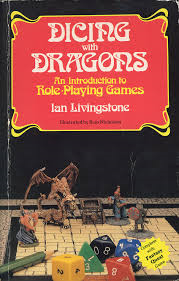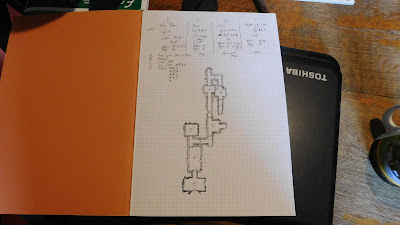To do Tunnels & Trolls justice I have split this review into four parts: this week I will be looking at the history of the system, its development over the past 40 or so years, and the latest incarnation, Deluxe Tunnels & Trolls. Next week I shall look at the character creation process, and the basic mechanics of the system. Week three will be solo roleplaying and the official solitaire adventures that have been released. Then the fourth instalment will look at a handful of the many third party adventures produced.
I have been into wargaming and roleplaying for quite a while now, and I had of course heard of Tunnels & Trolls, but that was about all. I was vaguely aware it was a roleplaying game, and assumed it was a low budget version of Dungeons & Dragons from back in the day.
It wasn't until a few months ago, when I read Dicing with Dragons that my interest was piqued.
Dicing with Dragons is a book from 1982, written by Ian Livingstone, who along with Steve Jackson not only formed Games Workshop, but also wrote the Fighting Fantasy series of game books.
In short they were responsible for my introduction into both wargaming and roleplaying. I read a lot of the Fighting Fantasy books as a young child. As an 11 year old I bought 'Dungeoneer' the Advanced Fighting Fantasy rulebook with a book token given to me as a leaving present from my primary school.
And this is what Ian Livingstone had to say about Tunnels & Trolls in his Introduction to Role-Playing Games:
[Tunnels & Trolls] does not attempt to explain every last detail of the world - the accent is on simplicity, fun and playability. It is much less complex than most other role-playing systems dealing with the same type of quasi-medieval fantasy world.
In common with some other RPGs, Tunnels & Trolls has a considerable number of ready-for-use adventures, but, unlike most others, which are generally designed for group play, most of the Tunnels & Trolls adventures are specifically designed for solitaire play, and thus fill a distinct need in the role-playing market.
This struck a chord.
Now I definitely prefer traditional, face-to-face group RPGs. They are an excuse for getting together with some like minded friends and having a laugh. I will admit also to attaching some stigma to solo RPGs: surely you have to be somewhat sad to try and recreate an RPG session by yourself. But really, when you think about it, that is not what you are doing. I don't play video games, but many people do. Alone. It doesn't make them social pariahs. A solo rpg is a very different animal to a group one. When you realise that, you realise that it is not either/or, but both.
My RPG circle are somewhat sporadic. We have been playing the same Dark Heresy adventure since Christmas. Admittedly we have had some deviations, a lot of the sessions seem to revolve around potato based recipes, but still...We don't play every week, sometimes we go a month or more between sessions. If I played solo adventures that would allow me to get an RPG fix between the group ones...
So I looked into Tunnels & Trolls. When Ian Livingstone was dicing with his dragons T&T was on it's 5th edition. Now in 2016 it is on its 9th. Wow. That's a lot of editions, is it even recognisable as the same game? Well in short, yes. To understand why let's look at its history.
In 1974 a gentleman by the name of Ken St. Andre got his hands on a copy of Dungeons & Dragons. The idea intrigued him, a game that would let him have the kind of adventures normally saved for Conan the Cimmerian or the Grey Mouser. But looking through the rule books, he couldn't make head nor tale of them. They were massively complex and so badly explained that unless you were personally shown how it all worked, you didn't have a hope of working it out for your self.
And so he wrote his own rules. In some way it was very similar to TSR's game. It was set in a broadly similar world, although maybe with a little less Tolkien and a little more Howard and Leiber. It had very similar basic attributes, though notably he got rid of Wisdom and added Luck, I think that says something.
Ken St Andre played the game with his group of friends in Arizona and it went down well. To start with they called it Dungeons & Dragons, for them (as for a lot of the general public even today) that was just what this type of game was called. When Ken wrote it all up he needed another name, Tunnels & Trolls seemed to fit the bill.
And so the second ever modern RPG was launched. Rick Loomis of Flying Buffalo sold most of the first printing of the rules for Ken at a convention, beginning a partnership which still lasts today.
The next few editions flew off, 2nd 3rd and 4th were I think running changes to 1st, reflecting the things Kens gaming group learnt along the way and all published with in the space of a few years. RPGs were new to everybody at this time and it was a steep learning curve.
In 1979 Ken and everybody at Flying Buffalo sat down and took a good look at the rules. The result was a thorough editing by Liz Danforth, who (along with everyone else) was to have a long association with the game.
The outcome, 5th edition was to become the official edition for the next 26 years. When Corgi released a paperback version of the rules in the UK (more on this next week) it was this version.
Then in 2005 Flying Buffalo released a version of the 5th edition rules with an extra section at the back, featuring Ken St. Andre's house rules which he had developed over the past couple of decades, this was labelled 5.5.
6th edition is now wrapped in shadow and folklore. It seems sometime around 2010 someone who did not have the rights to do so produced a new edition of the rules. This prompted Flying Buffalo to produce a new edition of their own. As a result the official, 7th, edition was a somewhat rushed affair. This was corrected with Tunnels & Trolls 7.5.
A couple of years ago a French edition of Tunnels & Trolls was produced, usually known as 8th edition. The production values on this were, by all accounts, a lot higher than any of the previous editions, the wonders of modern printing technologies.
Flying Buffalo and Ken St. Andre were inspired to produce a new rulebook, hopefully one that would rival 5th edition for it longevity and the French edition for its production. A Kickstarter was launched and a massive $125k was raised to prove that Tunnels & Trolls was very much alive and kicking.

And so the 9th edition of the rules is Deluxe Tunnels & Trolls. The rulebook took a lot longer than anyone anticipated, but it is now available to the general public. And it is a very nice book. To be clear though, this is not Pathfinder, nor is it D&D 5th ed. T&T is much closer to its roots than either of these games. In style it is more like the old-school OGL games. If you are expecting slick computer painted images then you will be disappointed. If you are expecting a highly-balanced system where you can spend a few evenings tweeking a character to get the most out of them, then you will be disappointed. If however you are looking for a simple, fun system with heart and soul, then this is the book for you. This is the book that Ken St Andre and Flying Buffalo would have produced in 1974 if they had been able.

Here, I feel I must have a little gripe. Flying Buffalo Inc are not a sleek, corporate enterprise. That isn't the gripe. I don't really like sleek, corporate enterprises. Give me a company I can actually put a face too any day. There is a downside though, and the downside to FBI is that they seem somewhat disorganised.
Getting a copy of Deluxe T&T in the UK was not as easy as it should have been. Amazon do not stock it. I have since found one UK based online RPG store that does, but I didn't find it in time, so I ordered it direct from Flying Buffalo, which cost quite a bit in postage. It also took over two months to get here and necessitated a lot of emails, quite a few of which failed to get a response.
Now I don't imagine for a minute that this experience is typical. Nor do I suggest they don't care about their customers, they obviously do. Flying Buffalo is a small company and I think that sometimes they struggle a bit with keeping so many balls in the air.
To my mind disorganisation is a small price to pay for a company where the people who designed the rules will answer your questions on facebook.
And so, back to the book itself. It is a step away from the previous editions in that it is a thick book, in fact not much lighter than the Pathfinder Core Rules. But then it isn't just core rules, it is everything you need to play, GameMastery Guide and Advanced Players Guide, and lots more all in one.
It contains (I think for the first time) a whole section on TrollWorld the 'official' setting for T&T. I put 'official' in inverted commas for a reason. Ken St. Andre and the other developers have always insisted that players should develop their own world. This is a view I agree with generally. If your campaign starts in a city, then just develop the city, or actually just the parts of the city you need. As the campaign grows so will the world. But some people don't like the world building and even for those of us that do the TrollWorld section provides plenty of inspiration.

The artwork in the book, as I think I alluded to before, is amazing. Actually I think it is my favourite artwork from any RPG book, certainly since the halcyon days of Advanced Fighting Fantasy. And that is probably the crux of it. Liz Danforth has been part of the T&T team since (I think) the 70s. And her art for the new book is wonderfully consistent with the old ones. It is immediately reminiscent of good old fashioned tales of Sword & Sorcery. It won't be for everyone, much like the book as a whole, but it sets the tone perfectly.
*** Most of the art appearing on this weeks blog is by and (c) Liz Danforth. She also does commissions, check out her website:
http://www.lizdanforth.com/ ***
Next Week:
More Tunnels & Trolls: character development and the basic mechanics.























































